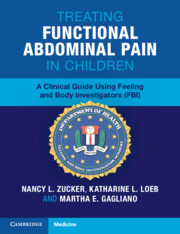 Treating Functional Abdominal Pain in Children
Treating Functional Abdominal Pain in Children from Part II - A Session-by-Session Guide to Feeling and Body Investigators
Published online by Cambridge University Press: 18 November 2023
The Drowsies is our session about sleep. As a restful night of sleep is an important part of any pain management routine, we wanted to devote a session just to that. We explore that sensations that make it hard to get into bed (e.g., Stuck Stephanie – the feeling that you can’t stop doing something that you like doing (like playing video games) to do something you would rather not do (like get ready for bed). We remember some old friends that that may make it hard to fall asleep like Mind-Racing Mikella and Betty Butterfly and we investigate all the sensations that may contribute to a wonderful and cozy night of rest. Cozy Celeste, Sleepy Steven, Cool Cyrus, and Stretched-Out Comfy Cayla are some sensations we explore this session. Wait till you try out all of our different bedtime routines!
To save this book to your Kindle, first ensure [email protected] is added to your Approved Personal Document E-mail List under your Personal Document Settings on the Manage Your Content and Devices page of your Amazon account. Then enter the ‘name’ part of your Kindle email address below. Find out more about saving to your Kindle.
Note you can select to save to either the @free.kindle.com or @kindle.com variations. ‘@free.kindle.com’ emails are free but can only be saved to your device when it is connected to wi-fi. ‘@kindle.com’ emails can be delivered even when you are not connected to wi-fi, but note that service fees apply.
Find out more about the Kindle Personal Document Service.
To save content items to your account, please confirm that you agree to abide by our usage policies. If this is the first time you use this feature, you will be asked to authorise Cambridge Core to connect with your account. Find out more about saving content to Dropbox.
To save content items to your account, please confirm that you agree to abide by our usage policies. If this is the first time you use this feature, you will be asked to authorise Cambridge Core to connect with your account. Find out more about saving content to Google Drive.